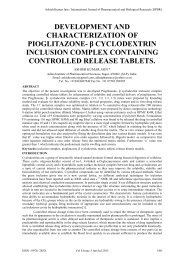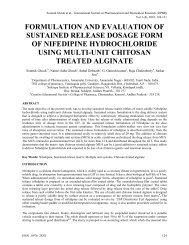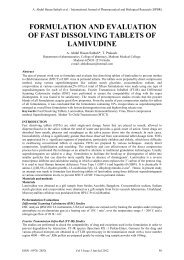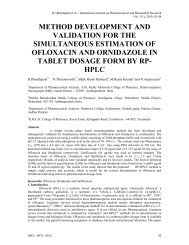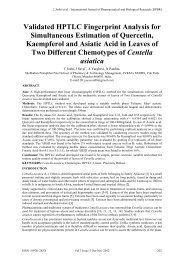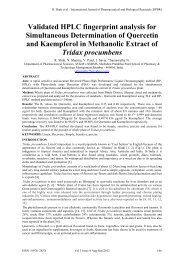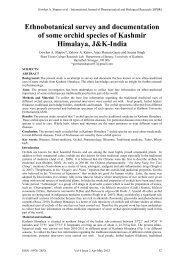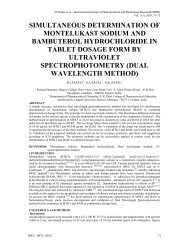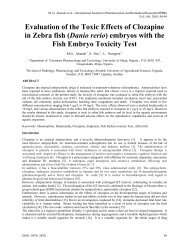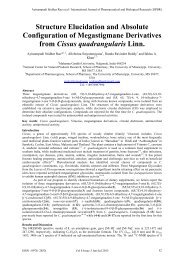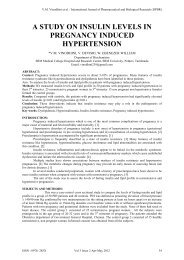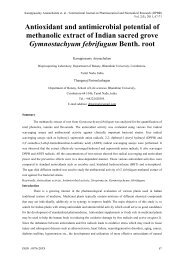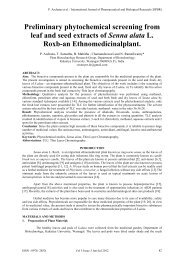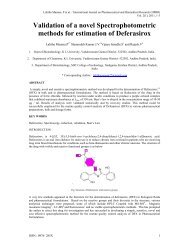ANTIMICROBIAL ACTIVITY OF METHANOLIC EXTRACT FROM ...
ANTIMICROBIAL ACTIVITY OF METHANOLIC EXTRACT FROM ...
ANTIMICROBIAL ACTIVITY OF METHANOLIC EXTRACT FROM ...
You also want an ePaper? Increase the reach of your titles
YUMPU automatically turns print PDFs into web optimized ePapers that Google loves.
Dynashwar K.Mhaske et al. / International Journal on Pharmaceutical and Biomedical Research (IJPBR)<br />
Vol. 2(4), 2011, 107-111<br />
<strong>ANTIMICROBIAL</strong> <strong>ACTIVITY</strong> <strong>OF</strong><br />
<strong>METHANOLIC</strong> <strong>EXTRACT</strong> <strong>FROM</strong><br />
RHIZOME And ROOTS <strong>OF</strong><br />
VALERIANA WALLICHII<br />
Dynashwar K.Mhaske 1. Dinanath D. Patil 2 , Gurumeet C. Wadhawa 3<br />
1 Principal R.B.N.B .College Shrirampur .<br />
2 Head department of chemistry, R.B.N.B. College shrirampur,<br />
3 Post-Graduate Department of Chemistry and Research Centre, R.B.N.B. College, Shrirampur- 413 709(MS)<br />
E-mail address: wadhava_gc2004@rediffmail.com<br />
Abstract – The plant root and stem occurs in short, irregular pieces about 5 cm long and 6-12 cm in diameters<br />
marked with transverse ridges and bearing numerous, prominent, circular tubercles, to some of which on the<br />
under surface, thick rootlets are attached. The upper surface bears the remains of leaves. The rhizome is hard<br />
and tough internally, it is greenish-brown in color. The odour is powerfully valerianaceous both root and<br />
raizome are studied for antibacterial and antifungal activity in plants, root shows excellent antibacterial and<br />
antifungal activity.<br />
Keywords – Antibacterial activity, Polarity, valeriana wallichii, methanol<br />
Introduction –<br />
Valeriana wallichii is an extremely polymorphous complex of sub-species with natural populations dispersed<br />
throughout temperate and sub-polar Eurasian zones. The species is common in damp woods, ditches, and along<br />
streams in Europe, and is cultivated as a medicinal plant, especially in Belgium, England, Eastern Europe,<br />
France, Germany, India, the Netherlands, the Russian Federation, and the United States of America.<br />
Rhizome, with epidermis of polygonal cells, having the outer walls slightly thickened; cork, immediately below<br />
the epidermis, of up to 7 layers of slightly suberized, brownish, large polygonal cells; cortex, parenchymatous<br />
with rather thick-walled parenchyma, containing numerous starch granules and traversed by numerous roottraces;<br />
endodermis of a single layer of tangentially elongated cells containing globules of volatile oil; pericycle,<br />
parenchymatous; vascular bundles, collateral, in a ring and surrounding a very large parenchymatous pith,<br />
containing starch granules and occasional scattered groups of sclereids with thick pitted walls and narrow<br />
lumen; xylem, with slender, annular, spiral, and pitted vessels, in small numbers. Branches similar to rhizome<br />
but with a prominent endodermis and a well-defined ring of vascular bundles, showing second-ary thickening.<br />
Root, with piliferous layer, of papillosed cells, some developed into root hairs; exodermises, or a single layer of<br />
quadrangular to polygonal cells, with suberized walls, and containing globules of volatile oil; cortex,<br />
parenchyma-tous, with numerous starch granules, the outermost cells containing globules of volatile oil;<br />
endodermis, of 1 layer of cells with thickened radial walls; primary xylem, of 3–11 arches surrounding a small<br />
central parenchymatous pith con-taining starch granules, 5–15....m in diameter, sometimes showing a cleft or<br />
stellate hilum; the compound granules, with 2–6 components, up to 20....m in diameter. Older roots show a pith<br />
of starch-bearing parenchyma, vascular bundles with secondary thickening and a periderm originating in the<br />
piliferous layer.<br />
Plant Material and Preparation of Extracts:<br />
Preparatin of various extract of VALERIANA WALLICHII bark:<br />
Around 1kg of fresh shade dried bark was powdered and around 800gm were extracted by hot<br />
percolation method by soxhalate apparatus. With five liter of each pet-ether (40-60 0 c) chloroform, acetone and<br />
methanol successively. All the extracts finally reduced to dryness at 40degree c by rotary evaporator<br />
(Rotavapour Buchhi Switzerland).<br />
The quantity of each extract after the extraction was pet. Ether (15gm), chloroform (20gm), Acetone<br />
(12gm), Methanol (40gm), aqueous extracts (28gm).
Dynashwar K.Mhaske et al. / International Journal on Pharmaceutical and Biomedical Research (IJPBR)<br />
Vol. 2(4), 2011, 107-111<br />
Preparation of various extract of VALERIANA WALLICHII Root:<br />
In present study we use dry stem of the plant collected from western ghat region Maharashtra. Dried stems<br />
are cut into small pieces these pieces are then grinded. The grinded sample is dark brown in colour with a<br />
special smell.<br />
This powder stirred in non-polar solvent i. e. CCl4, for 1/2 hour & then it is refluxed for 1/2 hour this is<br />
performed for extraction of non-polar component from powder. After extraction the CCl4 layer is distilled to<br />
recover solvent & to get a brown colored liquid fraction which shows single spot on thin layer chromatography.<br />
The residue of CCl4 extraction is used for further study. This residue is mixed with CHCl3 & stirred for 1/2 hour<br />
& then refluxed for 1 hour. After filtration the filtrate is distilled to get CHCl3 Fraction which is Red-brown<br />
colored liquid.<br />
Then the Residue of CHCl3 is used for extraction with Ethyl acetate stirred well & refluxed for 1 hour<br />
then filtered. Filtrate is then distilled & fraction of Ethyl acetate is collected it shows no spot on TLC plate.<br />
Conclusion is that no organic compound is present.<br />
The Ethyl acetate residue is further mixed with methanol & stirred for 1/2 hr & refluxed for 1hr. Then<br />
it is filtered & filtrate is distilled out.Methanol fraction is yellow brown in colour & show single spot On TLC<br />
platte<br />
The remaining residue also have smell & it is observed that residue is insect repellant.<br />
Microorganisms:<br />
The test microorganism used for antimicrobial activity screening were & bacteria (2 gram +ve) - Enterococcus<br />
faecalis, Staphylococcus onerous, (2gram –ve) - Klebsiallea pneumaniae, Escherichia coli, and two fungi-<br />
Candida albicans and Aspergillus fumigants.<br />
These organisms were identified a procured from Nikhil analytical laboratory Sangli, Maharashtra.<br />
Antimicrobial Activity:<br />
The agar diffusion method [11] was used to evaluate the antimicrobial activity. Bacteria were cultured overnight<br />
at 37 o C in Mueller Hinton 10 µl Broth (MHB, Oxoid) and fungi at 28 o C for 72h in Potato Dextrose Broth<br />
(PDB, Oxide) and used as inoculums. A final inoculums, using 100 µl of suspension containing 10 8 CFV/ml of<br />
bacteria 10 4 spore/ml of fungi spread on Mueller Hinton Agar (MHA) and Potato Dextrose Agar (PDA)<br />
medium respectively.<br />
The disc (6 mm in diameter) was impregnated with 10 µl of 75 µl/ml, 50 µl/ml, 25 µl/ml, 10 µl/ml and 5 µl/ml<br />
of each extracts and for each organism placed on seeded agar. Ciprofloxacin and Fluconazole (75 µl/ml, 50<br />
µl/ml, 25 µl/ml, 10 µl/ml and 5 µl/ml) were used as positive control bacteria and fungi respectively. The test<br />
plates were incubated at 37 o C for 24h for bacteria and at 28 o C for 72h for fungi depending on the incubation<br />
time required for a visible growth.<br />
MIC values were also studied for microorganisms by turbidimetric method, which were determined as sensitive<br />
to the extracts in cup plate method. MIC was defined as the lowest concentration of extract that inhibit visible<br />
growth.
Dynashwar K.Mhaske et al. / International Journal on Pharmaceutical and Biomedical Research (IJPBR)<br />
Vol. 2(4), 2011, 107-111<br />
Table-1 Antibacterial activity of methanolic extract from extract from Rhizome of Valeriana wallichii<br />
Bacterial Extract<br />
ethanolic<br />
Extract CCl4 Cefotax Penicil Tetrax<br />
G (+)<br />
In mm In mm In mm In mm In mm<br />
1. Staphylococcus<br />
epidermidis<br />
2. Staphylococcus<br />
oureus<br />
3. Bacillus paludis<br />
4. Bacillus subtilis<br />
G (-)<br />
1. Escherichia Coli<br />
2. Pseudomonus<br />
aeruginosa<br />
3. Shigella flaxinely<br />
4. Enterobacter aero<br />
genes<br />
9 8 7 10 9<br />
7 12 10 8 8<br />
12 8 11 10 8<br />
7 8 11 10 7<br />
3 2 4 3.5 5.5<br />
4 2 4 3 3.5<br />
3 4 4.5 3.5 4<br />
3 4 5 3 2.<br />
Table-II; Antifungal activity of ethanilic extract from <strong>EXTRACT</strong> <strong>FROM</strong> Rhizome of Valeriana wallichii<br />
Fungus Extract<br />
ethanolic<br />
Extract CCl4 Cefotax Penicil Tetrax<br />
1. Candida albicans 7 6 7 5 9<br />
2. Aspergillus fumigatus 6 8 5 7 4<br />
3. Aspergillus niger 4 3 8 4 5<br />
Table-III Antibacterial activity of methanolic extract from root of Valeriana wallichii plant.<br />
Bacteria Extract<br />
ethanolic<br />
Extract CCl4 Cefotax Penicil Tetrax<br />
G (+)<br />
In mm In mm<br />
1. Staphylococcus<br />
epidermidis<br />
2. Staphylococcus<br />
oureus<br />
3. Bacillus paludis<br />
4. Bacillus subtilis<br />
G (-)<br />
1. Escherichia Coli<br />
2. Pseudomonus<br />
aeruginosa<br />
3. Shigella flaxinely<br />
4. Enterobacter aero<br />
genes<br />
12 11 10 10 10<br />
12 10 10 8 8<br />
10 9 10 11 9<br />
12 5 11 10 9<br />
8 9 4 3.5 5.5<br />
10 9 4 3 3.5<br />
11 9 4.5 3.5 4<br />
12 4 5 3 2.
Dynashwar K.Mhaske et al. / International Journal on Pharmaceutical and Biomedical Research (IJPBR)<br />
Vol. 2(4), 2011, 107-111<br />
Table-IV; Antifungal activity of methanolic extract from root of delonix regia plant.<br />
Fungus Extract<br />
mthanolic<br />
Extract CCl4 Cefotax Penicil Tetrax<br />
1. Candida albicans 13 5 7 5 4<br />
2. Aspergillus<br />
Fumigatus<br />
3. Aspergillus niger<br />
10 9 5 6 4<br />
11 8 6 4 5<br />
(Value represents MIC values expressed in ug/ml.)<br />
A comparison is shown between the antibiotic activities of the plant extract with reference antibiotics<br />
(Cefotaxime). Na-cefotaxime, (Pencil) benzyl penicillin sodium and (tetrac) tetracycline R=absence of<br />
inhibition even at the highest concentration used (100 ug/ml)<br />
1. Tested material: Methanolic extract was obtained after the degatting with petroleum ether (40º-60º) and<br />
CHCl3.<br />
2. Studied activities: Antibacterial activity was studied using the MIC broth dilution method. (8, 9)<br />
3. Organism used: for the antibacterial activity standard bacterial strains, obtained from the Nikhil Analytical<br />
Laboratory, Sangli (Maharashtra).<br />
Result:<br />
The results of Antimicrobial activity were done for all the five, pet ether, chloroform, acetone, and methanol and<br />
aqueous extracts. During antimicrobial study methanolic extracts showed maximum zone of inhibition against<br />
almost all organisms in cup plate method.<br />
Conclusion:<br />
The methanolic extract from roots of Valeriana wallichii<br />
showed a good inhibition against all the bacterial Strains tested (MIC between 10&80 ug/ml). The gram (+)<br />
bacteria were sensitive with gram (-) bacteria and some common fungi.<br />
Acknowledgement:<br />
We are grateful to the Principal Dr. D.K.Mhaske , R.B.N.B.College, Shrirampur for inspiring us and<br />
providing laboratory facility . Nikhil analytical and research laboratory, Sangli (M.S.) India for their technical<br />
assistance.<br />
References :<br />
[1] African pharmacopoeia, 1st ed. Lagos, Organization of African Unity Technical & Research Commission, 1985.<br />
[2] British pharmacopoeia. London, Her Majesty’s Stationery Office, 1988.<br />
[3] Deutsches Arzneibuch 1996. Stuttgart, Deutscher Apotheker Verlag, 1996.<br />
[4] European pharmacopoeia, 2nd ed. Strasbourg, Council of Europe, 1995.<br />
[5] Pharmacopée française. Paris, Adrapharm, 1996.<br />
[6] Pharmacopoea hungarica VII. Budapest, Medicina konyvkiado, 1986.<br />
[7] The Japanese pharmacopoeia XIII. Tokyo, Ministry of Health and Welfare, 1996.<br />
[8] Morazzoni P, Bombardelli E. Valeriana officinalis: traditional use and recent evaluation of activity. Fitoterapia, 1995, 66:99–112.<br />
[9] Youngken HW. Textbook of pharmacognosy, 6th ed. Philadelphia, Blakiston,1950.<br />
[10] Bisset NG. Max Wichtl’s herbal drugs & phytopharmaceuticals. Boca Raton, FL, CRC, Press, 1994.<br />
[11] Farnsworth, NR. ed. NAPRALERT database. Chicago, University of Illinois at Chicago, IL, March 15, 1995 production (an on-line<br />
database available directly through the University of Illinois at Chicago or through the Scientific and Technical Network (STN) of<br />
Chemical Abstracts Services).<br />
[12] Bruneton J. Pharmacology, phytochemistry, medicinal plants. Paris, Lavoisier 1995.<br />
[13] Jackson BP, Snowden DW. Atlas of microscopy of medicinal plants, culinary herbs and spices. Boca Raton, FL, CRC Press, 1990.<br />
[14] Quality control methods for medicinal plant materials. Geneva, World Health Organization, 1998.<br />
[15] Deutsches Arzneibuch 1996. Vol. 2. Methoden der Biologie. Stuttgart, Deutscher Apotheker Verlag, 1996.<br />
[16] European pharmacopoeia, 3rd ed. Strasbourg, Council of Europe, 1997.<br />
[17] Guidelines for predicting dietary intake of pesticide residues, 2nd rev. ed. Geneva, World Health Organization, 1997 (unpublished<br />
document WHO/FSF/FOS/97.7; available from Food Safety, WHO, 1211 Geneva 27, Switzerland).<br />
[18] Feytag WE. Bestimmung von Valerensäuren und Valerenal neben Valepotriaten in Valeriana officinalis durch HPLC.<br />
Pharmazeutische Zeitung, 1983, 128:2869 2871.
Dynashwar K.Mhaske et al. / International Journal on Pharmaceutical and Biomedical Research (IJPBR)<br />
Vol. 2(4), 2011, 107-111<br />
[19] Van Meer JH, Labadie RP. Straight-phase and reverse phase high-performance liquid chromatographic separations of valepotriate<br />
isomers and homologues. Journal of chromatography, 1981, 205:206–212.<br />
[20] Graf E, Bornkessel B. Analytische und pharmazeutisch-technologische Versuche mit Baldrian. Deutsche Apotheker Zeitung, 1978,<br />
118:503–505.<br />
[21] Hänsel R, Schultz J. Valerensäuren und Valerenal als Leitstoffe des offizinellen Baldrians. Bestimmung mittels HPLC-Technik.<br />
Deutsche Apotheker Zeitung, 1982,122 333–340..WHO monographs on selected medicinal plants 276<br />
[22] Leathwood PD, Chauffard F. Quantifying the effects of mild sedatives. Journal ofpsychological research, 1982/1983, 17:115.



